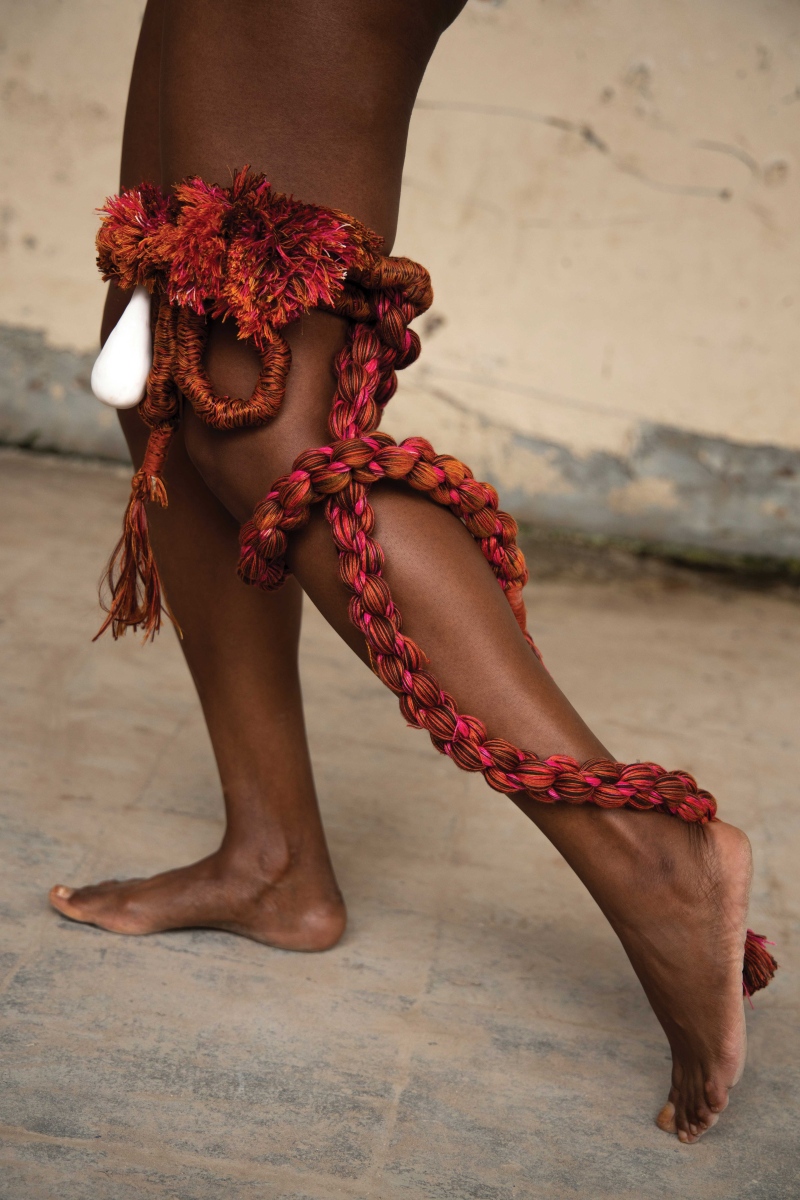
Hidden stories #4
12 March 2025
Uncovering our collection
Behind these sculptural jewellery pieces by Yinka Buutfeld lies a raw reality. In this blog, curator-in-training Lauren Hermans tells you more about her works and the important message they carry.

Yinka Buutfeld, 'Agbara Statement Leg Charm' uit de serie AGBARA, 2021, collectie TextielMuseum. Photo: Iris Rijskamp.
Between strength and vulnerability: Yinka Buutfelds AGBARA series
Yinka Buutfelds' (1995, Lagos) impressive AGBARA series forces you to reflect on deep-rooted social problems, such as skin bleaching and its devastating effects on body and mind. The works Agbara Statement Arm Bracelet and Agbara Statement Leg Charm, both part of this series, are much more than wearable accessories. They tell stories of oppression, colonialism and the search for self-worth, with a clear message: all skin colours should be valued and celebrated.

Yinka Buutfeld, ‘Agbara Statement Arm Bracelet’ uit de serie AGBARA, 2021, collectie TextielMuseum. Photo: Yinka Buutfeld.
Objects with a statement
Since studying at the Design Academy Eindhoven, Buutfeld has used her design practice to highlight social issues that concern identity, power systems and the human body. Her 2021 graduation project refers to the global problem of skin bleaching, in which the pigment melanin is removed from the skin by products containing harmful chemicals such as mercury and hydroquinone. The desire to bleach one's skin to meet ‘the’ ideal beauty standard stems from a long history of white supremacy. Mainly dark-skinned people are under pressure to use these products. The series comments on the still-pervasive impact of colonial history and the influence of dominant norms of the Global North on cultures beyond. Rather than referring to a geographically defined area in the traditional sense, the Global North refers to the relative power and wealth of countries in different parts of the world, such as North America, Europe and Australia. This term is commonly used instead of the Eurocentric terms such as Western and non-Western.
The title AGBARA, which means ‘power’ in Yoruba (the most commonly spoken language in Nigeria), reflects the intention behind the works. Buutfeld, whose roots lie in Nigeria, uses her series to encourage us to think about the strength that lies deep within ourselves and which does not depend on external appreciation. The wearable artworks are inspired by Manila jewellery from West Africa, which in the past were used as money for the slave trade and were often used as decorative elements in domestic settings. The violent history embedded in this jewellery is one of the examples of historiography that has not made it into the history books in Europe. This is precisely why Buutfeld chooses this symbol of slavery trade intentionally and transforms it into something beautiful: a celebration of the body.

Anoniem voor ons, manilla's, bronze bracelets, ca. 1700, collection Het Scheepvaartsmuseum
Oppressive beauty
At first glance, the Agbara Statement Arm Bracelet and Leg Charm may come across as simply sculptural accessories. Only when you look closer does a complex and layered story unfold, in which the form follows the meaning of the piece. The jewellery appears protective, but because Buutfeld has treated the raw marine ropes with bleaching agents, the harmful effects of skin bleaching suddenly become painfully tangible. The material is at once strong and fragile. The bleached shipping rope and ceramic beads, made in collaboration with ceramic artist Sterre ter Beek, emphasise the contrast between the soft, fragile body and the harsh reality of harmful beauty standards.
In the case of the Arm Bracelet, the dishevelled ends of the threads seem to break out of the tightly sheathed rope. In this way, they break out of the shackles of dominant, white beauty standards both symbolically and literally. The tightly wrapped ropes of the Leg Charm, the leg piece, also suggest entrapment. The long, dangling cords are so intertwined that parts of them appear to be getting pinched off. The work illustrates how the aggressive chemicals in skin bleach not only remove the pigment melanin, but also physically damage the body.

Yinka Buutfeld, detail van 'Agbara Statement Leg Charm' uit de serie AGBARA, 2021, collectie TextielMuseum. Photo: Yinka Buutfeld.
Textile techniques and narratives
Buutfeld developed her graduation project AGBARA at the TextielLab of the TextielMuseum, working at the passementerie department, a collective term for decorative textiles such as ties, fringes and cords. Buutfeld's thick cords are machine braided, twisted and gimped on 19th-century machines. The yarn is wound very tightly around old ship ropes, using a huge amount of yarn, plus a drill and weights. This gives Buutfeld's works their sleek, strong look. The works literally exude agbara (strength). Nevertheless, a certain tenderness and softness remains in her work and its message by choosing textiles as a medium. The medium's strength lies precisely in this combination: despite its soft appearance and outdated/historical associations with gentleness, textile/work manages to address strong and urgent themes.

Detailfoto van de machinale vlechtmachine van het TextielLab. Photo: Josefina Eikenaar.
Buutfelds' extraordinary work has not gone unnoticed. Two years after developing the work at the TextielLab, the TextielMuseum purchases two of the six pieces from the AGBARA series. These were added to the sub-collection wearable objects jewelry made of textiles, within the visual arts sub-collection. The fact that these wearable objects are not primarily meant to be worn, but conceptually tell a story, makes them transgressive across different art categories. In this respect, they function as body-related art, an art form that takes the body as its starting point, but takes on a broader meaning in the context of visual art.
With her AGBARA series, Buutfeld opens an important dialogue regarding beauty, identity and the destructive influence of social norms rooted in colonial thought. Her work reminds us that art can be a powerful tool to tell stories and create awareness.